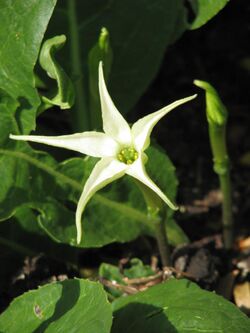Biology:Jaborosa
| Jaborosa | |
|---|---|

| |
| Jaborosa integrifolia | |
| Scientific classification | |
| Kingdom: | Plantae
|
| (unranked): | |
| (unranked): | |
| (unranked): | |
| Order: | |
| Family: | |
| Genus: | Jaborosa Juss.
|
| Species | |
|
about 23, see text | |
Jaborosa is a genus of flowering plants in the family Solanaceae, the nightshades. There are about 23 species,[1][2][3] all native to South America, where they are distributed from Peru to Patagonia. Most occur in the Andes.[3] Most can be found in Argentina [4] and ten are endemic to the country.[3]
Description
Most Jaborosa are rhizomatous perennial herbs except J. bergii and J. sativa, which are annual or biennial.[3]
Ecology
J. rotacea is pollinated by flies, and J. runcinata is pollinated by moths.[3] Sphingid moths feed on the nectar of J. integrifolia.[4]
Chemistry
Like plants in several other Solanaceae genera, many Jaborosa species contain steroid-derived compounds called withanolides.[5] Many of the withanolides isolated from Jaborosa have been dubbed jaborosalactones. Some withanolides are phytotoxic, having effects on other plants such as inhibiting germination and radicle growth.[5] Some have antifeedant effects, deterring insects such as mealworms (Tenebrio molitor),[2] the Mediterranean fruit fly (Ceratitis capitata),[1] and the African cotton leafworm (Spodoptera littoralis)[6] from consuming the plant.
Diversity
- Jaborosa ameghinoi
- Jaborosa araucana
- Jaborosa bergii
- Jaborosa cabrerae[8]
- Jaborosa caulescens
- Jaborosa chubutensis
- Jaborosa integrifolia
- Jaborosa kurtzii
- Jaborosa lanigera
- Jaborosa leucotricha
- Jaborosa magellanica
- Jaborosa odonelliana
- Jaborosa oxipetala
- Jaborosa parviflora
- Jaborosa pinnata
- Jaborosa reflexa
- Jaborosa riojana
- Jaborosa rotacea
- Jaborosa runcinata
- Jaborosa sativa
- Jaborosa squarrosa
- Jaborosa volkmannii
References
- ↑ 1.0 1.1 Tettamanzi, M. Cristina; Biurrun, Fernando N.; Cirigliano, Adriana M. (2007). "A New Antifeedant Withanolide from Jaborosa lanigera". Zeitschrift für Naturforschung B 62 (4): 573–576. doi:10.1515/znb-2007-0415.
- ↑ 2.0 2.1 Bonetto, Gloria M.; Gil, Roberto R.; Oberti, Juan C.; Veleiro, Adriana S.; Burton, Gerardo (1995). "Novel Withanolides from Jaborosa sativa". Journal of Natural Products 58 (5): 705–711. doi:10.1021/np50119a008.
- ↑ 3.0 3.1 3.2 3.3 3.4 3.5 Chiarini, Franco E.; Barboza, Gloria E. (2008). "Karyological studies in Jaborosa (Solanaceae)". Botanical Journal of the Linnean Society 156 (3): 467–478. doi:10.1111/j.1095-8339.2007.00734.x. https://collegiannews.com/wp-content/uploads/2018/09/62_CHIARINI%202008%20Karyological%20studies%20in%20Jaborosa.pdf.
- ↑ 4.0 4.1 Vesprini, J. L.; Galetto, L. (2000). "The reproductive biology ofJaborosa integrifolia (Solanaceae): Why its fruits are so rare?". Plant Systematics and Evolution 225 (1–4): 15–28. doi:10.1007/BF00985456.
- ↑ 5.0 5.1 Nicotra, Viviana E.; Ramacciotti, Natalia S.; Gil, Roberto R.; Oberti, Juan C.; Feresin, Gabriela E.; Guerrero, Cecilia A.; Baggio, Ricardo F.; Garland, M. Teresa et al. (2006). "Phytotoxic Withanolides from Jaborosa rotacea". Journal of Natural Products 69 (5): 783–789. doi:10.1021/np0600090.
- ↑ Vaccarini, Clarisa; Bonetto, Gloria (2000). "Antifeedant Activity Evaluation of Withanolides from Jaborosa integrifolia". Molecules 5 (12): 422–423. doi:10.3390/50300422.
- ↑ Jaborosa. Solanaceae Source. Retrieved 6 July 2013.
- ↑ Barboza, G. (1986). "Una nueva especie de Jaborosa (Solanaceae)". Kurtziana 18: 89–92. ISSN 0075-7314.
Wikidata ☰ Q144712 entry
 |

